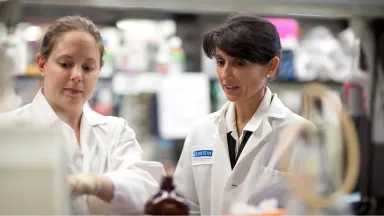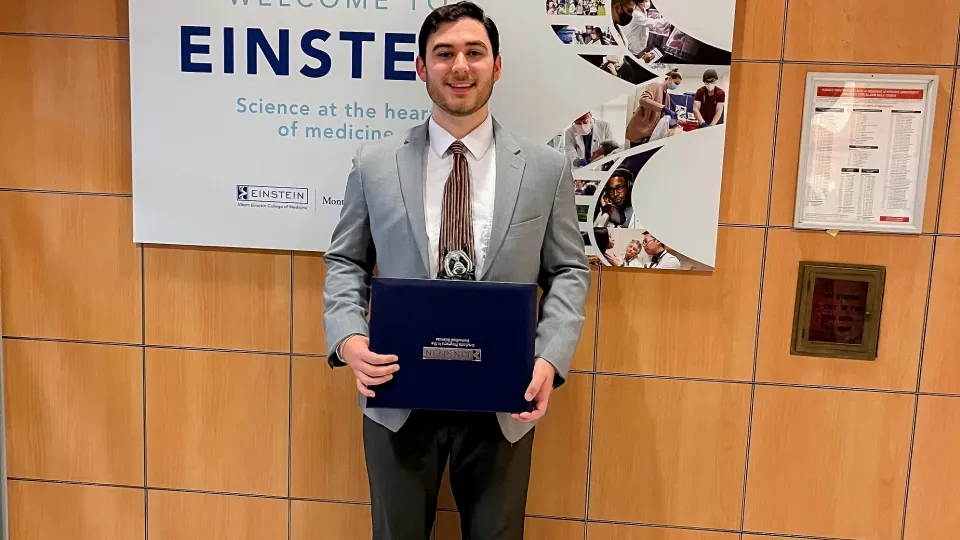
Julie Secombe, Ph.D.
- Professor, Department of Genetics
- Professor, Dominick P. Purpura Department of Neuroscience
Area of research
- Chromatin and transcription, Histone demethylase, Intellectual Disability, Neurodevelopmental disorders, Cancer, iPSCs, Drosophila
Phone
Location
- Albert Einstein College of Medicine Jack and Pearl Resnick Campus 1300 Morris Park Avenue Ullmann Building 809 Bronx, NY 10461
Research Profiles
Professional Interests
Our lab is broadly focused on understanding the molecular functions of the lysinedemethylase 5 (KDM5) family of transcriptional regulators. KDM5 proteins are distinguished by their unique combination of chromatin-modifying and chromatin-binding domains, enabling them to regulate gene expression through multiple, distinct mechanisms. These proteins are essential for normal development, and their misregulation has been implicated in two very different disorders, cancer and intellectual disability (ID).
Despite their importance, effective therapies for KDM5-related disorders remain elusive, mainly because the full spectrum of KDM5 target genes and regulatory mechanisms is not yet understood. To address this, we use two complementary model systems. First, we leverage the genetic tractability of Drosophila melanogaster, which encodes a single, essential KDM5 ortholog. Second, we utilize human-induced pluripotent stem cells (iPSCs) to investigate the function of KDM5A, KDM5B, and KDM5C in human induced neurons and brain organoids, thereby providing a translational perspective on disorder-relevant mechanisms.
Current projects in the lab:
- Defining the gene expression and chromatin changes in fly strains harboring alleles that are analogous to those found in ID patients. All pathogenic missense variants in human KDM5 genes occur in evolutionarily conserved residues.
- Examining neuronal and behavioral phenotypes of Kdm5 ID-variant animals and identifying KDM5 target genes to gain insight into how loss of human KDM5 genes results in intellectual disability.
- Defining the fundamental mechanisms of KDM5 that are necessary during development to produce viable adult flies.
- Developing human iPSC models of KDM5 family ID, focusing initially on the X-linked KDM5C gene that causes Claes-Jensen syndrome.
Selected Publications
- Yheskel, M., Castiglione, M.A., J. Secombe (2025) Local chromatin context informs transcriptional outcomes for the histone demethylase KDM5. Epigenetics & Chromatin, 18. 10.1186/s13072-025-00644-z. PMID:41340160
- Yheskel, M., Hatch, H.A.M., Pedrosa, E., Terry, B. K., Siebels, A. A., Zheng, X.Y., Blok, L.E.R., Fencková, M., Sidoli, S., Schenck, A., Zheng, D., Lachman, H.M., and J. Secombe (2024). KDM5-mediated transcriptional activation of ribosomal protein genes alters translational efficiency to regulate mitochondrial metabolism in neurons. Nucleic Acids Research, 52 (11), 6201-6219. PMID:38597673
- Rogers, M.F., Marshall, O.J., and J. Secombe (2023). KDM5-mediated activation of genes required for mitochondrial biology is necessary for viability in Drosophila. Development, doi.org/10.1242/dev.202024 PMID:37800333Schneider, B.K., Sun, S., Lee, M., Li, W., Skvir, N., Neretti, N., Vijg, J., and J. Secombe (2023) Expression of transposons contributes to aging in Drosophila. Genetics, DOI: 10.1093/genetics/iyad073
- Yheskel, M., Sidoli, S., and J. Secombe (2023). Proximity labeling reveals a new in vivo network of interactors for the histone demethylase KDM5. Epigenetics & Chromatin 16(8) doi.org/10.1186/s13072-023-00481-y. PMID:36803422.
- Schneider, B.K., Sun, S., Lee, M., Li, W., Skvir, N., Neretti, N., Vijg, J., and J. Secombe (2023). Expression of transposons contributes to aging in Drosophila.Genetics, DOI: 10.1093/genetics/iyad073. PMID:37084379
- Belalcazar, H.M., Hendricks, E.L., Zamurrad, S., Liebl, F.L.W., and J Secombe (2021). The histone demethylase KDM5 is required for synaptic structure and function at the Drosophila neuromuscular junction. Cell Reports, 34(7):108753. DOI:10.1016/j.celrep.2021.108753. PMID:33596422
- Hatch, H.A.M., Belalcazar H.M., Marshall O.J., and J. Secombe (2021). A KDM5-Prospero transcriptional axis functions during early neurodevelopment to regulate mushroom body formation. eLife doi.org/10.7554/elife.63886 PMID: 33729157
- Hatch, H.A.M., O’Neill, M.H., Marion, R.W., Secombe, J.#., and L.H. Shulman# (2021). Caregiver-reported characteristics of children diagnosed with pathogenic variants in KDM5C. American Journal of Medical Genetics - Part A, doi:10.1002/amjg.a.62381 PMID:34089235
# co-corresponding authors. - Drelon, C., Belalcazar, H.M. and J. Secombe (2019) The histone demethylase KDM5 controls developmental timing by promoting prothoracic gland endocycles. Development, 146:dev182568 doi: 10.1242/dev.182568. PMID:31862793
- Chen, K., Luan, X., Liu, Q., Wang, J., Chang X., Snijders A. M., Mao J-H., Secombe J., Dan Z., Chen J-H., Wang Z., Dong X., Qiu C., Chang X., Zhang D., Celniker S. E., and X. Liu (2019). Drosophila KDM5 regulates social behavior through immune control and gut microbiota maintenance. Cell Host & Microbe 25, 1-16. PMID:30902578
- Zamurrad, S., Hatch, H.A.M., Drelon, C., Belalcazar, H.M., and J. Secombe (2018). A Drosophila model of intellectual disability caused by mutations in the histone demethylase KDM5. Cell Reports 22, 2359-2369.
- Drelon, C., Belalcazar, H.M., and J. Secombe (2018). The histone demethylase KDM5 is essential for larval growth in Drosophila. Genetics. pii: genetics.301004.2018. doi: 10.1534/genetics.118.301004.








